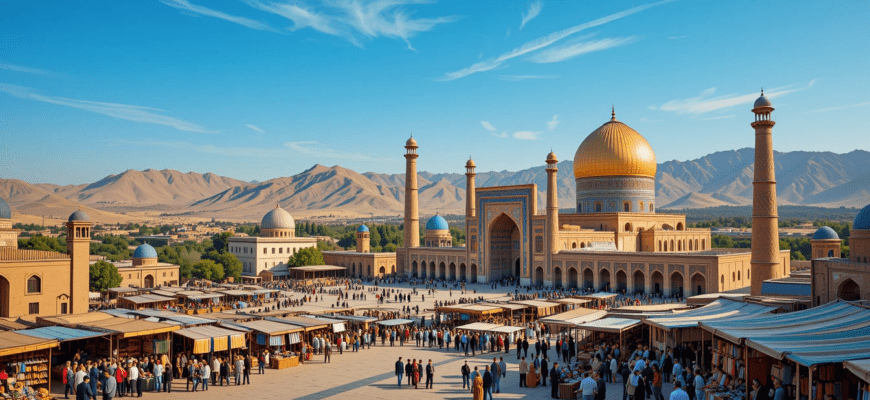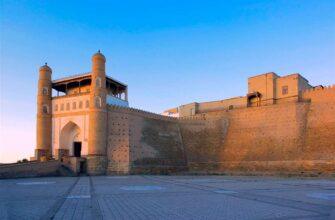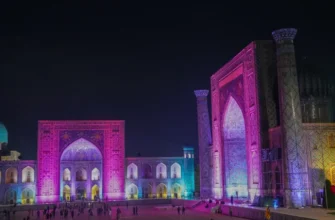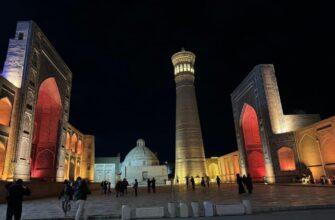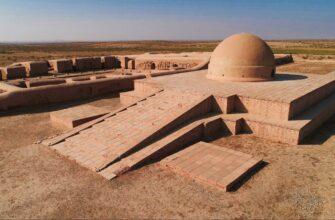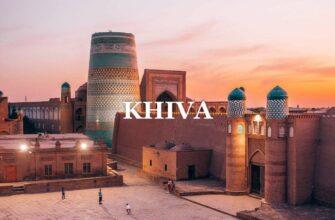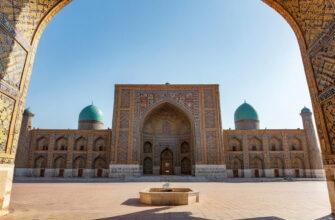Uzbekistan, a land rich in history along the ancient Silk Road, beckons travelers with its vibrant culture and stunning architecture. From majestic mosques to sprawling bazaars, this Central Asian gem promises experiences that are as diverse as its landscapes. Each corner offers a glimpse into centuries-old traditions, making it a captivating destination for adventurers and historians alike.
The country is home to series of cities that showcase its illustrious past, with Samarkand, Bukhara, and Khiva standing out as must-visit locations. In addition to its urban allure, Uzbekistan boasts breathtaking natural wonders like Aydarkul Lake and the Nurota Mountains, offering a perfect blend of exploration and relaxation. Cultural highlights, such as the bustling Chorsu Bazaar in Tashkent, further enhance the experience by immersing visitors in local life.
To help you navigate this enchanting country, this article will provide a comprehensive guide to the best places to visit in Uzbekistan. From tailored itineraries for varying durations to essential travel tips, get ready to discover the treasures of Uzbekistan.
Top Cities to Explore
Uzbekistan boasts enchanting cities filled with history and charm. Each destination offers unique experiences that showcase the country’s rich past and vibrant cultural diversity. Here’s a look at three must-visit cities:
Samarkand
Samarkand, located in southeastern Uzbekistan, is one of Central Asia’s oldest cities. It dates back to the late Paleolithic Era. Founded between the 7th and 8th centuries BC, Samarkand was a significant trade hub on the ancient Silk Road. This city connects China and the Mediterranean Sea, shaping its history.
Key attractions in Samarkand include the Registan Square, Gur-e-Amir Mausoleum, and Shah-i-Zinda Complex. These sites highlight exquisite Islamic architecture and timeless beauty. The architecture in Samarkand reflects the area’s rich cultural legacy. The Gur-e-Amir Mausoleum, with its stunning azure dome and intricate design, stands out as one of the iconic structures built in the 14th century. Samarkand’s vibrant culture draws pilgrims and architecture lovers alike, making it a beautiful blend of history and artistry.
Bukhara
Bukhara, designated as a UNESCO World Heritage site, is renowned for its well-preserved medieval architecture. Notable landmarks include historic mosques, madrasas, and the Ark of Bukhara fortress. The Ark served as the residence for emirs from the 5th century until 1920. Visitors can explore its royal town, which includes a mosque and various museums.
Bukhara, a prominent city along the Silk Road since around 500 BC, contains over 150 historical monuments. This reflects its role as a major trading hub. The city’s narrow alleyways and bustling bazaars offer visitors an authentic experience of its cultural heritage. Key highlights include the Lyabi-Hauz complex and the Kalon Minaret, each symbolizing Bukhara’s architectural grandeur.
Khiva
Khiva is a beautifully preserved medieval desert town. It rose to prominence in the 16th century as the capital of the Khans of Khiva. The inner walled city, known as Ichan Kala, is like an open-air museum with 51 monuments, encircled by thick mud walls. This historic site provides a glimpse into the region’s Silk Road history.
Among Khiva’s notable landmarks is the Kalta Minor Minaret, famous for its turquoise tilework, although it remains unfinished. The Juma Mosque, dating back to the 10th century, is another key site within Khiva with its 218 wooden columns. In 1990, Khiva became Uzbekistan’s first UNESCO World Heritage site, renowned for its exceptional Silk Road heritage.
These cities encapsulate the essence of Uzbekistan, offering diverse experiences and historical insights at every turn. Whether it’s the architectural marvel of Samarkand, the regal history of Bukhara, or Khiva’s scenic beauty, each provides a unique window into the country’s fascinating past.
Natural Attractions
Uzbekistan is well-known for its variety of natural landscapes. From deserts to mountains and lakes, it offers many adventures and nature experiences. The country provides eco-tourism activities like staying in local guesthouses and hiking in nature reserves.
Aydarkul Lake
Aydarkul Lake is a stunning place in the Kyzylkum Desert. This semi-natural lake covers over 4,000 square kilometers. Created by the Soviets, it offers unique activities like camel rides and yurt stays. In spring and summer, colorful flowers bloom around the lake, enhancing its beauty. The water is great for swimming from June to August. If you love fishing, the best times are between September and April. Although a bit remote, it is worth the journey to experience its peace.
Nurota Mountains
The Nurota mountain range stretches between Dizzak and Nurata towns. Founded by Alexander the Great, it includes the famous Nurata Nature Reserve. Here, you can find endangered mountain sheep and rare birds. Trekking in these mountains lets you explore historical ruins and experience local life. If you enjoy bird watching, you’ll find plenty to see. You can even swim in Adyar Lake, hidden within the mountains. The Nurota Mountains offer a mix of natural beauty and cultural experiences.
Experience Uzbekistan through its beautiful natural attractions, from serene lakes to majestic mountains.
Cultural Highlights
Uzbekistan is a land of vibrant culture and history. The country is famous for its stunning architecture and warm hospitality. Along the ancient Silk Road, cities like Samarkand, Bukhara, and Khiva share tales of a rich past. Samarkand is known as one of the oldest cities in Central Asia. The city’s architectural marvels like Registan Square and the Gur-e-Amir Mausoleum are a must-see. Moreover, Bukhara is a UNESCO World Heritage site. It boasts historical treasures with its mosques and madrasas. The best time to visit Uzbekistan is between April to May or September to early November. During these months, travelers find the weather most pleasant.
Chorsu Bazaar in Tashkent
In Tashkent, Chorsu Bazaar stands as a bustling market that is almost 100 years old. It is the biggest and oldest bazaar in Uzbekistan and Central Asia. Its large domed structures and colorful glazed tiles make it a visual treat. Here, you can explore daily necessities, traditional crafts, and fresh fruit. A striking blue dome protects this lively market in Tashkent’s center. Nearby, the Kukeldash Madrasah enriches the area’s cultural vibe.
Historical Sites of Uzbekistan
Uzbekistan is a treasure trove of historical sites. The cities of Samarkand, Bukhara, and Khiva are UNESCO World Heritage sites, each telling tales of the past. Samarkand’s Registan Square is a splendid architectural wonder. It comprises three madrasahs built between the 15th and 17th centuries. Bukhara’s Ark Fortress once housed the city’s emirs and showcases medieval charm. Meanwhile, Khiva’s Walled City, or Itchan Kala, is noted for its brick walls and historical depth. While in Samarkand, don’t miss the Gur-e-Amir Mausoleum, the resting place of Timur. Another notable site is the Shah-i-Zinda necropolis, known for its beautiful tilework and mausoleums.
Tailored Itineraries
One-Week Itinerary
Start your journey in Tashkent, the capital city of Uzbekistan. Take time to explore the vibrant streets before settling down for the night. The next day, venture to the Fergana Valley. Visit Margilan and Rishtan to see their famous silk production. Your adventure continues in Kokand with a night train ride to Khiva. Here, you can explore the well-preserved architecture or take a day trip to the Khorezm Fortresses for a dose of history. The week ends with a visit to Bukhara, where you can take day trips and also admire the Kyzyl Kum desert with an overnight stay under the stars.
Two-Week Itinerary
This two-week itinerary begins with your arrival in Tashkent, spending the night in this bustling city. Visit the serene Fergana Valley, then head to Khiva, Bukhara, and Samarkand. Each city offers unique insights into Uzbek culture and history. Stay several nights in these cities, especially in Bukhara and Samarkand. From Bukhara, consider day trips to explore the enchanting desert landscapes and the nearby Khorezm Fortresses. Complete your journey by reflecting on your travels as you return to Tashkent. This itinerary provides a comprehensive exploration of Uzbekistan’s rich heritage.
Four-Week Itinerary
Dive deep into the wonders of Uzbekistan with this four-week itinerary. Begin with two days in Tashkent, then embark on an enriching tour of the Fergana Valley and the scenic Chimgan Mountains. Continue to Nukus and Karakalpakstan for a unique perspective on the country. Spend time in Khiva and Bukhara, where history comes alive with well-preserved architecture and vibrant culture. Visit the Nuratau Mountains for a taste of nature from days 15 to 18. Experience Samarkand’s stunning landmarks, like Registan Square, before you head back to Tashkent. Highlight the best of your travel experience by savoring the perfect blend of cultural, historical, and natural attractions across Uzbekistan.
One-Week Itinerary
One-Week Itinerary in Uzbekistan
Day 1: Arrive in Tashkent
- Explore the capital city
- Overnight stay
Day 2: Discover Fergana Valley
- Visit Margilan for silk production
- Stop by Rishtan known for ceramics
- Overnight in Fergana
Day 3: Journey to Kokand
- Explore Kokand’s rich history
- Catch a night train to Khiva
Day 4: Explore Khiva
- Walk through the ancient city
- Optional day trip to Khorezm Fortresses
Day 5-6: Head to Bukhara
- Enjoy beautiful architecture and local life
- Optional day trips around Bukhara
Day 7: Experience Kyzyl Kum Desert
- Overnight in the desert
- Return for departure
This itinerary immerses you in Uzbekistan’s cultural mix and historical depth. Each location offers a unique glimpse into its past and present. From bustling Tashkent to the serene deserts, Uzbekistan presents a rich tapestry of experiences.
Travel Tips
Uzbekistan is a country rich in history and natural beauty. There’s so much to explore, from ancient cities to stunning landscapes. Here are some travel tips to make the most out of your visit.
Best Times to Visit
The best time to visit Uzbekistan is during spring, from April to May, and autumn, from September to early November. During these months, the weather is warm and dry, making it ideal for exploring outdoor sites. Temperatures are comfortable and the climate is pleasant. Spring and autumn are busy seasons, as many tourists explore historical sites during this time. If you visit in summer or winter, be prepared for extreme temperatures. Summer highs can reach up to 40°C. To enjoy a quieter experience, consider visiting during the shoulder seasons.
Accommodation Recommendations
When it comes to accommodation, Uzbekistan offers plenty of options. By Lake Charvak, you can choose from hotels, tapchans, houses, and dachas, all of which provide beautiful views and access to recreational activities. In Chimgan, a place known for outdoor activities, you will find many chalets. Recommended stays include Chimgan Apple Garden, Gostevoi Dom Apachi, and Amirsoy Apple Dacha. Near tourist hotspots like Samarkand, Bukhara, and Khiva, there are options to suit all budgets. Staying at these places enhances your travel experience by immersing you in local culture.
For visitors to Uzbekistan, it’s wise to plan your stay to embrace the historical and cultural richness of this unique country. Whether you’re hiking in the Nurota mountains or exploring the Registan Square in Samarkand, choosing the right time and place to stay can make all the difference.

